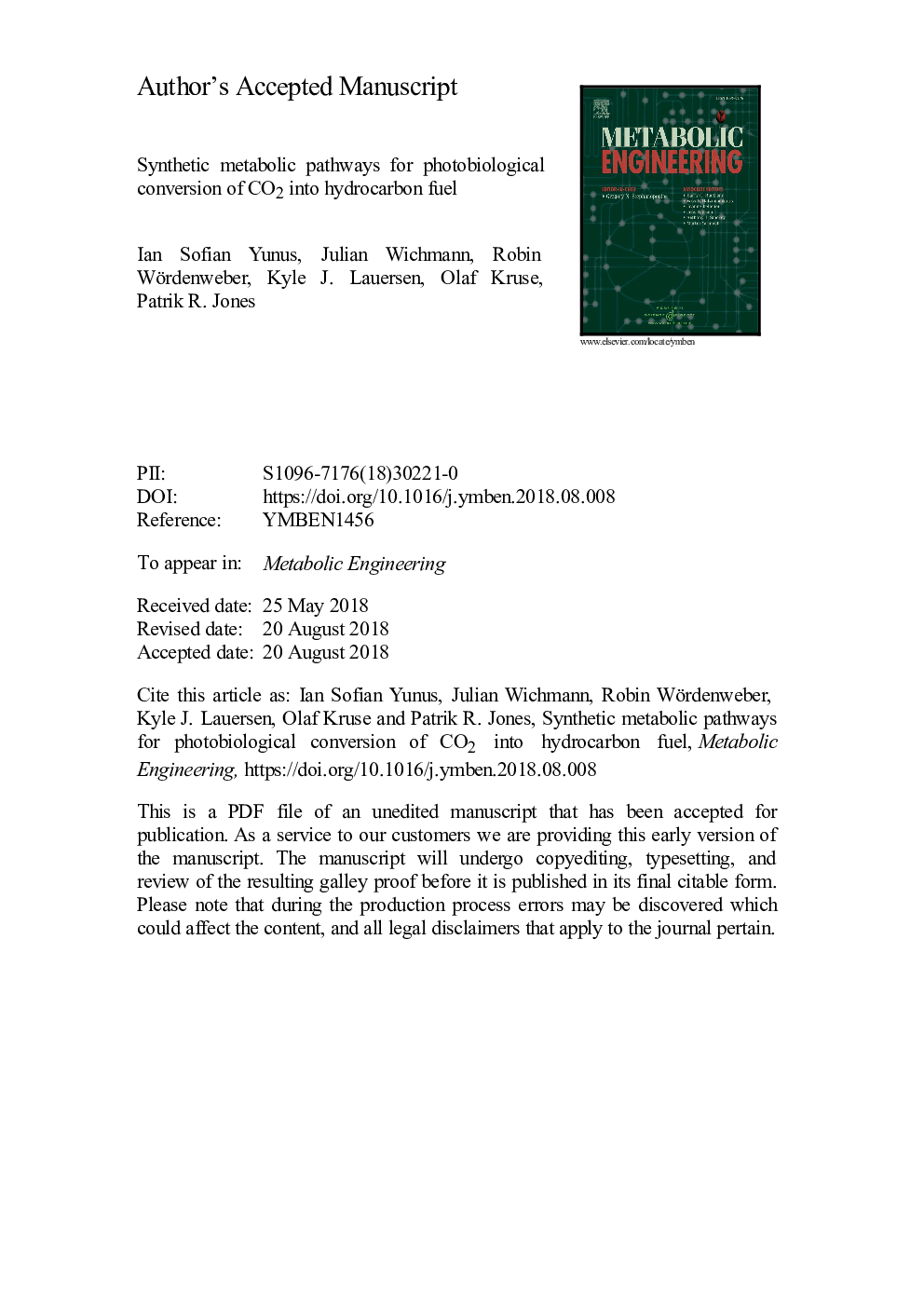| کد مقاله | کد نشریه | سال انتشار | مقاله انگلیسی | نسخه تمام متن |
|---|---|---|---|---|
| 10999840 | 1418330 | 2018 | 30 صفحه PDF | دانلود رایگان |
عنوان انگلیسی مقاله ISI
Synthetic metabolic pathways for photobiological conversion of CO2 into hydrocarbon fuel
دانلود مقاله + سفارش ترجمه
دانلود مقاله ISI انگلیسی
رایگان برای ایرانیان
کلمات کلیدی
موضوعات مرتبط
مهندسی و علوم پایه
مهندسی شیمی
بیو مهندسی (مهندسی زیستی)
پیش نمایش صفحه اول مقاله

چکیده انگلیسی
Liquid fuels sourced from fossil sources are the dominant energy form for mobile transport today. The consumption of fossil fuels is still increasing, resulting in a continued search for more sustainable methods to renew our supply of liquid fuel. Photosynthetic microorganisms naturally accumulate hydrocarbons that could serve as a replacement for fossil fuel, however productivities remain low. We report successful introduction of five synthetic metabolic pathways in two green cell factories, prokaryotic cyanobacteria and eukaryotic algae. Heterologous thioesterase expression enabled high-yield conversion of native fatty acyl-acyl carrier protein (ACP) into free fatty acids (FFA) in Synechocystis sp. PCC 6803 but not in Chlamydomonas reinhardtii where the polar lipid fraction instead was enhanced. Despite no increase in measurable FFA in Chlamydomonas, genetic recoding and over-production of the native fatty acid photodecarboxylase (FAP) resulted in increased accumulation of 7-heptadecene. Implementation of a carboxylic acid reductase (CAR) and aldehyde deformylating oxygenase (ADO) dependent synthetic pathway in Synechocystis resulted in the accumulation of fatty alcohols and a decrease in the native saturated alkanes. In contrast, the replacement of CAR and ADO with Pseudomonas mendocina UndB (so named as it is responsible for 1-undecene biosynthesis in Pseudomonas) or Chlorella variabilis FAP resulted in high-yield conversion of thioesterase-liberated FFAs into corresponding alkenes and alkanes, respectively. At best, the engineering resulted in an increase in hydrocarbon accumulation of 8- (from 1 to 8.5â¯mg/g cell dry weight) and 19-fold (from 4 to 77â¯mg/g cell dry weight) for Chlamydomonas and Synechocystis, respectively. In conclusion, reconstitution of the eukaryotic algae pathway in the prokaryotic cyanobacteria host generated the most effective system, highlighting opportunities for mix-and-match synthetic metabolism. These studies describe functioning synthetic metabolic pathways for hydrocarbon fuel synthesis in photosynthetic microorganisms for the first time, moving us closer to the commercial implementation of photobiocatalytic systems that directly convert CO2 into infrastructure-compatible fuels.
ناشر
Database: Elsevier - ScienceDirect (ساینس دایرکت)
Journal: Metabolic Engineering - Volume 49, September 2018, Pages 201-211
Journal: Metabolic Engineering - Volume 49, September 2018, Pages 201-211
نویسندگان
Ian Sofian Yunus, Julian Wichmann, Robin Wördenweber, Kyle J. Lauersen, Olaf Kruse, Patrik R. Jones,